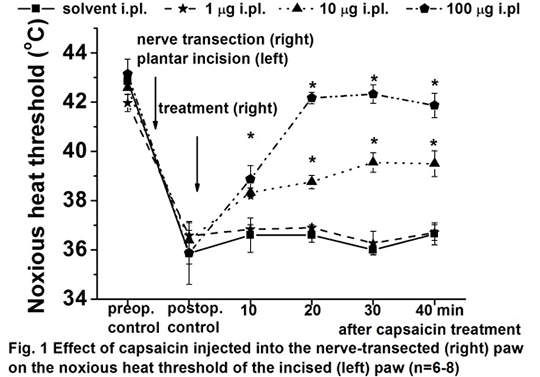Novel neurohumoral antihyperalgesic mechanism derived from the stimulation of peripheral capsaicin-sensitive nerve endings in the rat Somatostatin released from peptidergic capsaicin-sensitive primary afferents can exert a systemic anti-inflammatory effect in remote parts of the body (1,2). Since somatostatin was also reported to have an analgesic effect, the aim of the present study was to investigate in a postoperative pain model in rats if this neurohumoral counter-regulatory process involves a systemic antihyperalgesic effect as well. The noxious heat threshold of female Wistar rats (n=6-8/group) was measured with an increasing-temperature water bath (3). Rats were anaesthetized with sodium pentobarbital (50 mg/kg i.p.) and they underwent surgeries on each hind limb: a plantar incision on the left (3) and transection of the saphenous and sciatic nerves on the right. Rats were allowed to recover for 18 h. After measuring heat thresholds again, capsaicin was injected into the right paw (1, 10, 100 μg i.pl.) and measurements were repeated 10, 20, 30 and 40 min afterwards. In order to investigate the mechanism, the somatostatin receptor antagonist cyclosomatostatin (20 μg/kg i.p.) or the opioid receptor antagonist naloxone (3 mg/kg i.p.) was injected 20 min before 100 μg i.pl. capsaicin. Neurogenic origin was investigated by pretreatment of the right hind paw with 100 μg capsaicin 3 days before or nerve transections performed 5 days before plantar incision. Statistical comparison between solvent- and drug-treated groups was performed with Student's t-test for unpaired samples at each time point and p<0.05 was considered statistically significant. Plantar incision induced a marked decrease of the noxious heat threshold which was dose-dependently reversed by i.pl. capsaicin (Fig. 1). Maximal inhibition was observed at 20-30 min after treatment. Pretreatment with cyclosomatostatin or naloxone inhibited the remote antihyperalgesic effect of capsaicin. Prior desensitization of capsaicin-sensitive nerve endings or chronic denervation completely prevented the effects of capsaicin. Control, postoperative and 20 min posttreatment heat thresholds are compiled in Table 1.
In conclusion, chemical stimulation of decentralized capsaicin-sensitive nerve endings could evoke a remote antinociceptive effect which was shown to be mediated by somatostatin and endogenous opioids. This peripheral systemic neurohumoral response can be considered as a completely new regulatory mechanism of nociception. (1) Szolcsányi J et al (1998) Br J Pharmacol 123:936-942. (2) Szolcsányi J et al (1998) Br J Pharmacol 125:916-922. (3) Füredi R et al (2009) Eur J Pharmacol 605:63-67 |
|||||||||||||||||||||


